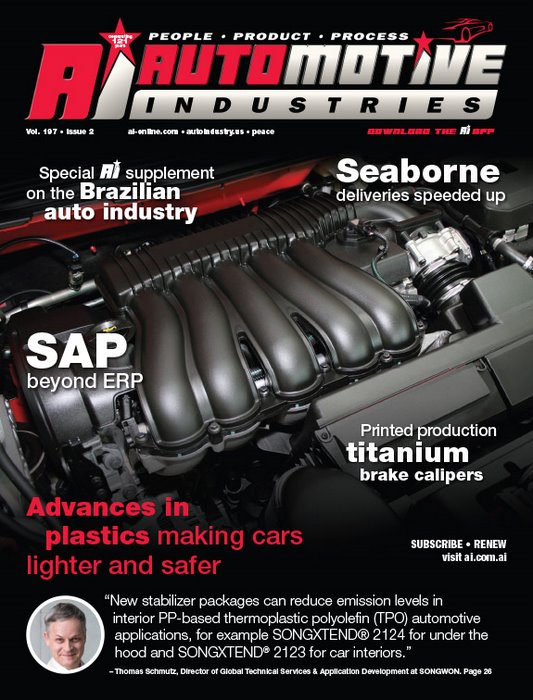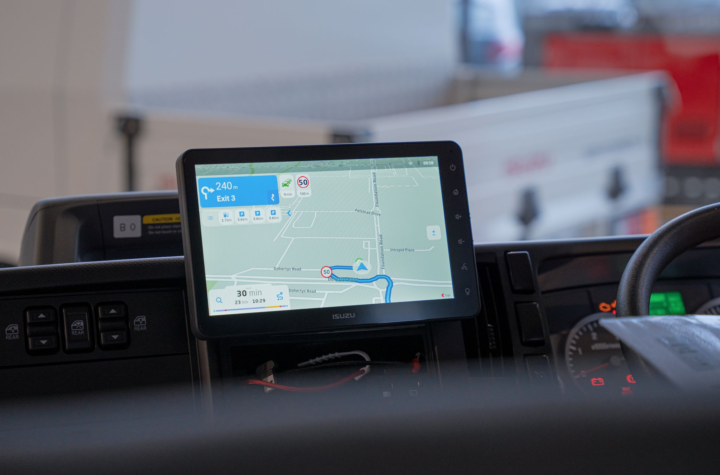
There is a growing range of applications, and uses, which include exterior components. SONGWON, one of the actors in the plastics field, is using its expertise to expand into additives and coatings.
Automotive Industries (AI) asked Thomas Schmutz, Director of Global Technical Services & Application Development at SONGWON to share some of the the new trends for plastics inside and outside the car.
Schmutz:Today plastics are used on an ever-growing scale for exterior parts such as fenders, headlights, doors and windows, and inside the car for items such as dashboards, head panels and upholstery. Plastic can also be used to achieve functional effects, such as sound, vibration, thermal and electrical insulation; and surface effects, including gloss and texture.
The main types of plastic used in cars are polypropylene (PP), polyurethane (PUR) and thermoplastic polyurethane (TPU), styrenics, acrylonitrile butadiene styrene (ABS), polycarbonate (PC), ABS/PC blends, polyamide (PA) and polybutylene terephthalate (PBT).
AI: What are polymer stabilizers and what are they used for in the automotive industry?
Schmutz:Both the exterior and the interior of vehicles are subjected to extreme conditions of heat and light, so the
plastics used need to be exceptionally resilient. Since plastic is not inherently resistant to light or heat it needs to be stabilized. Stabilizers protect the polymer from degradation. They include antioxidants, UV absorbers, hindered amine light stabilizers (HALS), and heat stabilizers.
AI: What are the biggest challenges in using polypropylene in interior applications?
Schmutz:Emissions from polypropylene (PP) are one of the biggest challenges faced by car manufacturers today. In automotive interior applications in particular, emissions depend on the quality (purity) and degradation of the polyolefin, and the solubility and inertness of the additives used. The industry is focusing strongly on reducing volatile organic compounds (VOCs) in automotive interior compounds. In response to this new trend, resin producers have introduced lowVOC products. However, these grades are more expensive than standard products and do not always meet profitability requirements.
AI: What solutions do you offer for reducing VOC emissions?
Schmutz:One way to reduce VOC emissions is to slow down the pelletization step after the polymerization of the PP, but this
increases the cost of the automotive resin. XP2085 experimental processing stabilizer for PP combines cost efficiency with
reduced VOC, allowing the resin producer to run the pelletization step faster. New stabilizer packages can reduce emission levels
in interior PP-based thermoplastic polyolefin (TPO) automotive applications, for example SONGXTEND® 2124 for under the hood
and SONGXTEND® 2123 for car interiors.
AI: We see more and more TPU resins as sheathing material of choice in automotive cable applications. What properties are required to achieve the best result?
Schmutz:In the last 20 years more and more driver assistance systems have been installed in cars to increase safety and comfort. Sensor cables, which transmit the electronic signals, must function reliably and without any outages throughout the lifetime of the car. Hence, they require a tough material for their outer sheathing. TPU is the material of choice. SONGSTOMER™ TPU P-3285A, for example, has excellent mechanical properties and strong resistance, especially to cutting, abrasion, bending, road stones, water and humidity. Heat and oxidation resistance is another important requirement. SONGSTOMER™ TPUs benefit from SONGWON’s in-depth knowledge of antioxidants.
Selecting and developing antioxidants that are fully compatible in the TPU matrix and do not cause blooming is one of the company’s strengths.
AI: Are there any other TPU applications in the automotive industry?
Schmutz:TPUs are also used in injection molding of exterior and interior automotive parts, mainly for aesthetic and haptic reasons. In addition, SONGSTOMER™ P-8185AI TPU resin is used in the manufacture of TPU blown films for automotive foamin-place seat applications on account of its ability to adhere to the fabric, its barrier properties, and its flexibility at low temperatures.
Anti-blocking properties ensure high productivity during film manufacturing. The product also confers strong resistance to tearing, cutting, puncturing and abrasion, and its high elongation and flexibility ensure that it is suitable for producing any shape.
AI: You have recently expanded your activities to include the development of additives for fuels and lubricants. How can you maintain engine performance and extend the drain interval of the engine oil?
Schmutz:Automobile engines now run at hotter temperatures and sump capacity tends to be lower, while hybrids and stopstart technologies can put extra strain on oils. SONGWON supports customers all over the world in meeting regional and nnational standards. SONGNOX® L670 aminic and SONGNOX® L135 phenolic antioxidants, for example, have synergistic effects and are used together to retard oxidation in engine oils, helping to sustain performance.
They extend drain intervals, maintain the required viscosity and reduce deposit formation, without compromising the durability of the engine. The products are used to stabilize passenger car motor oils (PCMO), heavy duty diesel engine oils (HDDEO), automatic transmission fluids (ATF) and gear oils (GO). Other applications include compressor, gear, turbine, metal-working oils and greases, whether mineral or synthetic.
AI: You are now also involved in the coatings field. What are the fundamental requirements for efficiency in the coatings manufacturing process?
Schmutz:The drive for efficiency and cost competitiveness in the coatings manufacturing process runs throughout the chain
from raw material suppliers to formulators and ultimately OEMs.
For SONGWON and its customers, the automotive coating formulators, this translates into four fundamental requirements:
• Coating processes that generate low or no VOC
• “Greener” and environmentally more compatible raw materials
• Enhancing the competitiveness of the coating process
• Improving the durability of the coating and protect the underlying substrate better.
In particular, improving the durability of the coating – and therefore the protection it provides – is seen as a way of reducing the need to replace parts and as an opportunity to stand out from the competition. All four drives translate into the need to develop
technologies that:
• Reduce environmental impact
• Allow the formulation of waterborne and powder coatings
• Generate low to zero VOC.
SONGWON supports its customers’ technology developments by offering a number of solutions and products. SONGSORB® CS AQ01 hindered amine light stabilizer (HALS) and SONGSORB® CS 400 liquid triazine UV absorber allow the formulation of lowto-zero VOC coatings, while enhancing durability and substrate protection. SONGSORB® CS B synergistic blends are multicomponent systems designed to increase performance and durability. SONGNOX® CS is a comprehensive range of primary and secondary antioxidants for more efficient formulation of coatings, while SONGSORB® CS solid hindered amine light stabilizers (HALS) can enhance the efficiency of the spray process.
AI: What’s next for SONGWON?
Schmutz:SONGWON aims to continue to support customers with products and processes that meet ever higher standards
and increasingly stringent regulations. This involves continuously enhancing the stability of additive products used in the manufacture of plastics for demanding automotive applications. SONGWON is focusing strongly on developing sustainable solutions that combine the properties sought by vehicle manufacturers and that can be tailor-made to their requirements.













More Stories
Finding the Car Boot Release Button – Tips and Tricks
What Happens During the Deposition Process of a Car Accident Case
Irdeto and ChargeHub Strengthen EV Charging Market with Seamless Plug & Charge Integration and Roaming Solution